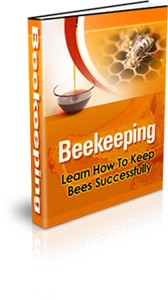 License Type: Private Label Rights
License Type: Private Label Rights  File Size: 423 KB
File Size: 423 KB File Type: ZIP
File Type: ZIP
 SKU: 425
SKU: 425  Shipping: Online Download
Shipping: Online Download
Ebook Sample Content Preview:
Plants have a glandular secretion, called nectar, which usually collects at the base of the flowers. Bees depend on this nectar for their source of energy. Honeybees dehydrate nectar to produce honey because it contains a low to moderate concentration of sugar. If a little pollen is incorporated into it, there can be barely measurable amounts of proteins, vitamins and other nutrients in the nectar.
There is two different ways bees use nectar. The nectar will work as a substitute for water, used to dilute brood food and air condition the hive. The bees can also ripen the nectar to become a stored resource for carbohydrate. The nectar substitute can also be used in either one of those ways, but the beekeeper use different sugar concentrations for different purposes.
Inspections of the colony should be conducted about every ten days during early and late spring. A beekeeper must stay aware of the conditions of the colony and the inspections will accomplish this. During the early spring the beekeeper must be aware of the food supply and if it is enough. During the late spring the beekeeper must be attentive to the possibility of swarming to keep it under control. Every inspection should inform the beekeeper if the bees have adequate food to get them through the times of bad weather. If they have enough to get them through until the next inspection, the beekeeper will again check their supply. If not, then the bees will have to be fed.
In the spring beekeepers will always feed the bees a pollen substitute and if the bees need to be fed sugar syrup. The sugar syrups fed early in the season are used for brood rearing. Feeding sugar usually stimulates egg laying and the syrup is usually a "light" syrup mixed with 1 part sugar and 1 par water. A heavy syrup, a mixture of 2 parts sugar and 1 part water, is fed late in the season to ensure adequate winter food supplies. They are stored as ripened syrup. If a medicated treatment is needed in the fall, feed for weight first, and then top off the colony with medicated syrup. There are beekeepers who use high fructose corn syrup to feed their bees, but they do not usually dilute the syrup regardless of the season. There are some levels of hydroxymethylfurfural (HMF) that will increase over time, especially with heat. HMG is toxic to honeybees at high enough concentrations.
It is best to feed the syrup to each colony individually. Every colony should receive its full share regardless of the size of the colony. It is best to feed in the evening, after the bees have settled down for the day. If there is a sudden abundance of syrup, bees will interpret this as an opportunity for robbing, by feeding after flying has ceased; the potential robbers find a source at home. Don't spill any on the hive, this will attract ants and robbing bees.
- File Size:423 KB
- License: Private Label Rights
- Category:Ebooks
- Tags:2007 Ebooks Private Label Rights








